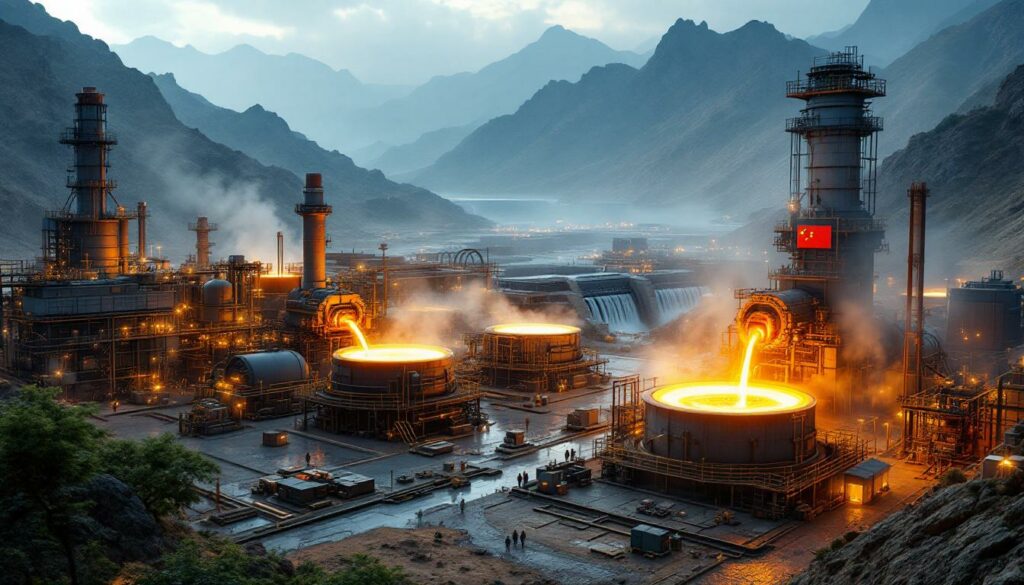What Drove the June 2025 Increase in Silicon Metal Production?
According to the latest data from Shanghai Metals Market (SMM), China's silicon metal production reached 327,700 metric tons in June 2025, marking a 6.5% increase month-over-month. However, this figure represents a substantial 27.7% decrease compared to the same period last year, indicating significant shifts in market dynamics despite the recent upward trend.
The cumulative production for the first half of 2025 stands at 1.8728 million metric tons, down 17.8% year-over-year, reflecting ongoing structural challenges within the industry evolution trends despite June's modest recovery.
Regional Production Drivers
The June increase was primarily driven by activity in three key regions, each experiencing unique production catalysts:
Xinjiang Region emerged as the most significant contributor to June's growth. Several previously idle production capacities resumed operations, boosting the region's output substantially. The stable power supply in this northern region provided a foundation for sustainable production increases.
Sichuan Region entered its annual rainy season, which typically enables increased hydropower generation. This seasonal shift allowed for limited production resumption. However, despite the month-over-month improvement, the region's output remains 38% below June 2024 levels, largely due to persistent profitability issues.
"Production in Sichuan was constrained by enterprise losses despite the increased hydropower availability during the rainy season," notes the SMM analysis.
Yunnan Region experienced a transitional period from dry to rainy season, creating favorable conditions for production expansion. Two new silicon metal projects launched operations during this period, contributing to the regional output increase. Despite this positive development, Yunnan's production remains dramatically lower—73% below last year's levels—highlighting the severity of the region's production challenges.
Regions with Declining Production
Not all regions contributed positively to June's production figures:
- Gansu Province recorded a month-over-month decrease due to scheduled maintenance activities at several facilities
- Inner Mongolia saw reduced output as multiple production units underwent maintenance
- Other Northern Regions experienced various maintenance-related production decreases that partially offset gains elsewhere
These maintenance periods, while temporarily reducing output, are essential for ensuring long-term operational efficiency and may position these regions for increased production in subsequent months.
How Does the Current Production Compare to Historical Trends?
The June 2025 production figure of 327,700 metric tons presents a complex picture when viewed against historical data. While the 6.5% month-over-month increase suggests short-term recovery, the 27.7% year-over-year decline reveals deeper structural challenges facing China's silicon metal production increase in June.
Year-over-Year Comparison Analysis
The 27.7% production decline compared to June 2024 represents one of the most significant year-over-year drops in recent history. Regional data provides further insights into this substantial contraction:
| Region | Year-over-Year Change (June 2025 vs. June 2024) |
|---|---|
| Sichuan | -38% |
| Yunnan | -73% |
| Overall | -27.7% |
The first half of 2025 shows a cumulative production of 1.8728 million metric tons, down 17.8% compared to the same period in 2024. This persistent downward trend indicates that June's modest month-over-month increase represents a potential stabilization rather than a significant recovery.
Market Context for Production Decline
Several interrelated factors explain the substantial year-over-year production decreases:
- Profitability pressures: Many producers, especially in southern regions, continue to operate at minimal margins or losses
- Operational constraints: Hydropower availability in key production regions creates seasonal limitations
- Structural changes: The geographic distribution of production capacity has shifted, with northern regions gaining relative importance
- Consolidation trends: Larger enterprises increasingly dominate production decisions, creating more concentrated market control
These challenges have collectively reshaped the production landscape, creating both regional disparities and overall capacity utilization reductions across China's silicon metal sector.
What Are the Production Forecasts for July 2025?
Silicon metal production forecasts for July 2025 show cautious optimism with significant regional variations expected. Industry analysts anticipate continued but modest growth, with specific regional developments driving the outlook.
Expected Regional Developments
Yunnan Region is projected to enter its full rainy season in July, creating favorable conditions for production expansion. SMM analysts estimate a month-over-month increase of approximately 10,000 metric tons from this region alone. This growth will be partially driven by production resumption in the Baoshan area and surrounding locations where hydropower availability is expected to improve substantially.
Sichuan Region will likely continue its production growth but at a slower pace compared to June. While the rainy season benefits will persist through July, enabling sustained hydropower generation, ongoing profitability concerns remain a significant constraint. Many facilities continue to operate below full capacity as manufacturers carefully balance output volumes against narrow profit margins.
Uncertainty Factors for July Production
The July production outlook contains several important elements of uncertainty:
North China Operations are expected to maintain relatively stable production levels. However, a key characteristic of this region is the dominance of large enterprises that control significant production capacity. This concentration means that operational decisions by a small number of major players can have outsized impacts on overall output.
Enterprise-Level Decisions by large producers will be particularly important to monitor. As SMM analysis notes, "Production scheduling for July is uncertain, and attention should be paid to the production decisions of large enterprises." These major manufacturers base their output decisions on complex assessments of market conditions, profitability projections, and strategic positioning.
Profitability Concerns continue to influence production decisions across all regions. Despite modest improvements in operating conditions in hydropower-dependent areas, many producers remain cautious about expanding output without corresponding improvements in profit margins.
How Are Regional Dynamics Shaping Silicon Metal Production?
The silicon metal production landscape in China demonstrates distinct regional characteristics that significantly influence overall output patterns. These regional differences create both challenges and opportunities for market participants.
Seasonal Impact on Production Capacity
Hydropower Availability serves as a critical factor in southern production regions, particularly Sichuan and Yunnan. These areas experience pronounced seasonal production patterns:
- Rainy Season (typically May/June through September/October): Increased hydropower generation enables higher production volumes at lower energy costs
- Dry Season (typically October/November through April/May): Limited hydropower constrains production and raises operating costs
- Transitional Periods: Shifting between seasons creates production volatility as manufacturers adjust to changing energy conditions
This seasonal dependency creates predictable production cycles that market participants have come to anticipate, though the exact timing and impact can vary from year to year based on precipitation patterns.
Regional Production Shifts reveal important differences between northern and southern production centers:
- Northern Regions (Xinjiang, Inner Mongolia, Gansu): Provide relatively stable year-round production with less seasonal variation
- Southern Regions (Sichuan, Yunnan): Contribute significant but highly variable output based on seasonal hydropower availability
These regional differences have become more pronounced in recent years as environmental regulations, energy policies, and profitability considerations have influenced capacity distribution across China.
Enterprise-Size Influence on Production Decisions
Silicon metal production in China shows increasing concentration among larger enterprises, particularly in northern regions. This market structure has several important implications:
- Concentrated decision-making: A relatively small number of major producers can significantly influence overall market supply
- Strategic production scheduling: Large enterprises often coordinate production plans based on market conditions
- Volatility potential: Collective decisions by major producers can create sudden supply shifts
This concentration requires close monitoring of major producer activities, as their operational strategies can create ripple effects throughout the entire silicon metal supply chain. Furthermore, the ongoing industry consolidation trends are reshaping the competitive landscape.
What Are the Market Implications of Production Changes?
June's production increase, while modest in historical context, carries significant market implications that extend beyond simple volume metrics. Understanding these implications requires examining both supply-demand dynamics and price effects.
Supply-Demand Balance Considerations
The 6.5% month-over-month production increase in June may help address tight supply conditions that had developed earlier in 2025. However, several factors complicate this apparent improvement:
- Year-over-year decline: Despite June's increase, the 27.7% reduction compared to June 2024 indicates a significant net decrease in available supply
- Regional production shifts: Changes in production distribution create logistical challenges and delivery timing differences
- Inventory positions: Current inventory levels throughout the supply chain influence how production changes affect actual availability
These factors suggest that while June's increased production provides some supply relief, it represents a stabilization rather than a return to previous supply levels. Additionally, the global copper supply forecast may indirectly impact silicon metal markets through broader metals industry trends.
Price Impact Analysis
Production increases typically moderate price pressures by improving product availability. However, several factors influence how June's production changes may affect pricing:
- Regional differentials: Production distribution shifts between northern and southern regions affect regional price variations
- Large enterprise influence: Concentrated decision-making among major producers creates potential for coordinated pricing strategies
- Seasonal expectations: Market participants anticipate and price in seasonal production patterns, particularly in hydropower-dependent regions
Given these considerations, June's production increase may have a stabilizing effect on prices, but significant upward or downward pressure would require more substantial production changes or demand shifts. In the broader context, electrification powering mines could also influence long-term demand patterns for silicon and other metals.
FAQ About Silicon Metal Production Trends
Why is there such a significant year-over-year decline in silicon metal production?
The 27.7% year-over-year decline in June 2025 stems from multiple interconnected factors. Profitability challenges have forced many producers to reduce output or temporarily halt operations. Operational constraints in key regions, particularly hydropower limitations in southern provinces during certain seasons, have restricted production capabilities. Additionally, structural changes in production capacity distribution across China have created regional imbalances that affect overall output volumes.
How does seasonal variation impact silicon metal production?
Silicon metal production in regions like Sichuan and Yunnan is heavily dependent on hydropower availability, which fluctuates seasonally. During the rainy season (approximately May/June through September/October), increased water flow enables greater hydropower generation, reducing energy costs and allowing higher production volumes. Conversely, the dry season (approximately October/November through April/May) brings limited hydropower capacity, higher energy costs, and reduced production capabilities. These seasonal patterns create predictable production cycles that market participants have learned to anticipate.
What factors will determine production levels for the remainder of 2025?
Key determinants for production levels through the rest of 2025 include hydropower availability in southern regions as the rainy season progresses, profitability margins for producers across all regions, operational decisions by large enterprises that control significant market share, and potential policy changes affecting energy-intensive industries. The critical minerals strategy may also influence production decisions as silicon metal is increasingly important for high-tech applications. The collective impact of these factors will shape both overall production volumes and regional distribution patterns through the remainder of the year.
How do regional production differences impact the overall market?
Regional production differences create supply variability, logistics challenges, and price differentials across China's silicon metal market. Northern regions provide relatively stable year-round production that helps maintain baseline supply levels. Southern regions contribute significant but seasonally variable production that creates cyclical supply patterns. These regional differences affect delivery times, transportation costs, and regional price variations. Additionally, the increasing concentration of production among large enterprises, particularly in northern regions, creates the potential for coordinated decision-making that can amplify market volatility.
Disclaimer: This analysis is based on current market data and industry observations. Future production levels and market conditions may vary based on changing economic circumstances, policy developments, and unforeseen events. Readers should consider this information as analysis rather than investment guidance.
Ready to Stay Ahead of Critical Mining Market Developments?
Discover real-time alerts on significant ASX mineral discoveries with Discovery Alert's proprietary Discovery IQ model, turning complex market data into actionable investment insights before the broader market catches on. Start your 30-day free trial today at Discovery Alert to gain your market-leading advantage in the mining and commodities sector.




